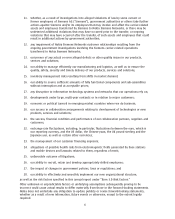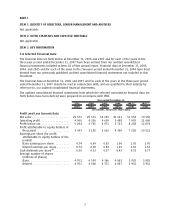Nokia 2007 Annual Report Download - page 17
Download and view the complete annual report
Please find page 17 of the 2007 Nokia annual report below. You can navigate through the pages in the report by either clicking on the pages listed below, or by using the keyword search tool below to find specific information within the annual report.possibility of alleged infringement and related intellectual property claims against us continues to
rise. The holders of patents and other intellectual property rights potentially relevant to our products
and solutions may be unknown to us, may have different business models, or may otherwise make it
difficult for us to acquire a license on commercially acceptable terms. There may also be technologies
licensed to and relied on by us that are subject to infringement or other corresponding allegations or
claims by others which could impair our ability to rely on such technologies. In addition, although we
endeavor to ensure that companies that work with us possess appropriate intellectual property rights
or licenses, we cannot fully avoid risks of intellectual property rights infringement created by
suppliers of components and various layers in our products, services and solutions or by companies
with which we work in cooperative research and development activities. Similarly, we and our
customers may face claims of infringement in connection with our customers’ use of our products,
services and solutions.
In many aspects, the business models for mobile services have not yet been established. The lack of
availability of licenses for copyrighted content, delayed negotiations, or restrictive copyright licensing
terms may have a material adverse effect on the cost or timing of content related services offered by
us, mobile network operators or thirdparty service providers, and may also indirectly affect the sales
of our mobile devices.
Since all technology standards, including those used and relied on by us, include some intellectual
property rights, we cannot fully avoid risks of a claim for infringement of such rights due to our
reliance on such standards. We believe that the number of third parties declaring their intellectual
property to be relevant to these standards, for example, the standards related to socalled 3G mobile
communication technologies, including 3GPP and 3GPP2, as well as other advanced mobile
communications standards, is increasing, which may increase the likelihood that we will be subject to
such claims in the future. While we believe that any such intellectual property rights declared and
found to be essential to a given standard carry with them an obligation to be licensed on fair,
reasonable and nondiscriminatory terms, not all intellectual property owners agree on the meaning
of that obligation and thus costly and timeconsuming litigation over such issues has resulted and
may continue to result in the future. While the rules of many standard setting bodies, such as the
European Telecommunication Standardization Institute, or ETSI, often apply on a global basis, the
enforcement of those rules may involve national courts, which means that there may be a risk of
different interpretation of those rules.
From time to time, some existing patent licenses may expire or otherwise become subject to
renegotiation. The inability to renew or finalize such arrangements with acceptable commercial terms
may result in costly and timeconsuming litigation, and any adverse result in any such litigation may
lead to restrictions on our ability to sell certain products, services or solutions, and could result in
payments that potentially could have a material adverse effect on our operating results. Most notably,
we are party to numerous legal proceedings with Qualcomm Incorporated (“Qualcomm” including its
affiliates). For more information about these legal proceedings with Qualcomm, see “Item 8.A.7
Litigation—Intellectual property rights litigation.” These legal proceedings may continue to be
expensive and timeconsuming and divert the efforts of our management and technical personnel
from our business, and, if decided against us, could result in restrictions on our ability to sell our
products, services and solutions, require us to pay increased licensing fees, substantial judgments,
settlements or other penalties and incur expenses that could have a material adverse effect on our
business and results of operations.
We recognize accruals and provisions to cover our estimated total direct IPR costs for our products,
services and solutions. The total direct IPR cost consists of actual payments to licensors, accrued
expenses under existing agreements and provisions for potential liabilities. We believe that our
accruals and provisions are appropriate for all technologies licensed from others. The ultimate
outcome, however, may differ from the provided level which could have a positive or negative impact
on our results of operations and financial position.
Any restrictions on our ability to sell our products, services and solutions due to expected or alleged
16
























